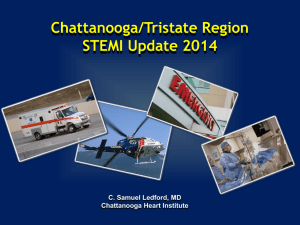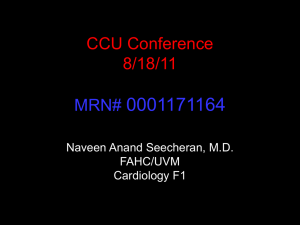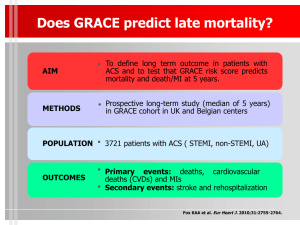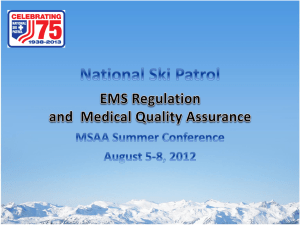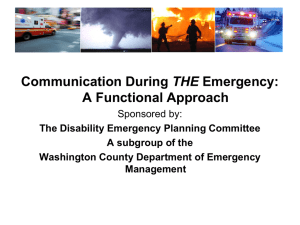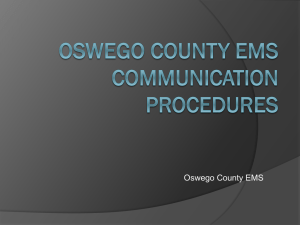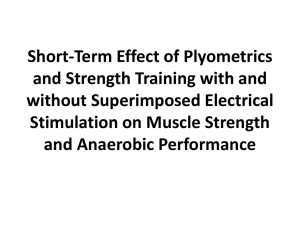STEMI BootCamp III: Building Your System
advertisement
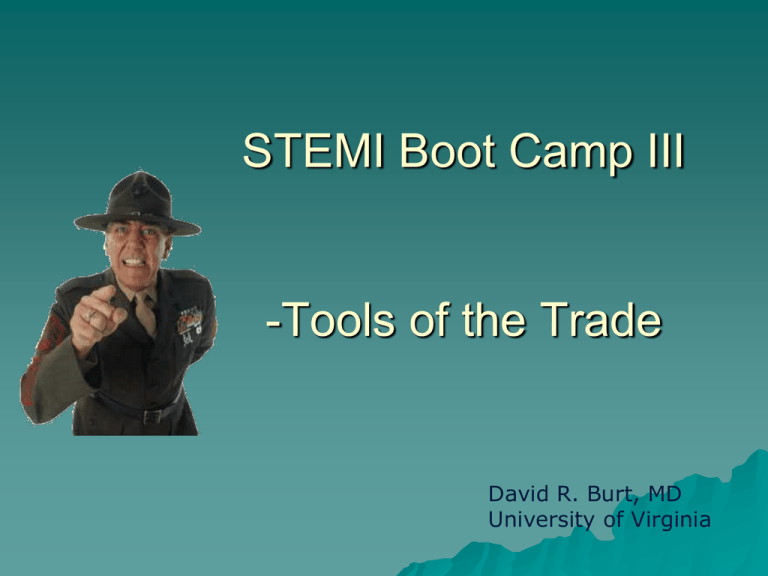
STEMI Boot Camp III -Tools of the Trade David R. Burt, MD University of Virginia STEMI Tool Kits… -Tactical Concepts Objectives: …Help you build a better system Now that you better understand the basic principles and theory behind STEMI system construction we want to discuss the tools available (at all levels) to help you optimize your individual Elemental STEMI subsystem! Remember: Building a Better System Requires Education… FACT: Educating a provider will not fix a “broken” system… but it helps! BUT: Fixing a system can support an “uncertain” provider THEREFORE: Fixing the system and educating the provider ensures success! I. The (Really) Big Picture National, community-based initiative Goals • • STEMI System Blueprints …courtesy of the AHA… 5 Working at all levels to improve care for STEMI patients 6 AHA: STEMI System Blueprints Mission: Lifeline Recommendations for Criteria for STEMI Systems of Care The criteria are divided into: Non-PCI Hospital/STEMI Referral Center PCI Hospital/STEMI-Receiving Center sections EMS STEMI Systems of Care Please visit the Mission: Lifeline portion of the American Heart Association website for all types of ideas for improving STEMI systems of care 8 II. D2B: PCI-center systems engineering The Door to Balloon Initiative (D2B), organized and spearheaded by the American College of Cardiology (ACC), was extremely successful in helping optimize STEMI care at PCI centers via its attention to systems level improvement as the key to sustainable success D2B: PCI Engineering 1. 2. 3. 4. 5. 6. ED physician activates cath lab One call activates the cath lab Cath lab team ready in 20-30 minutes Prompt data feedback Senior management commitment Team-based approach D2B: PCI-center systems engineering For more information on D2B, please visit the ACC website. III. Project UPSTART: STEMI System Builder’s Toolkit Project UPSTART: A Reperfusion Toolkit for All Situations Project UPSTART was designed as an integrated set of concepts, processes and procedures that can be used to help efficiently address issues that are common in any local STEMI system So, Optimize Recognition and Reperfusion… All attempts at reducing STEMI treatment times must ultimately focus on improving one (or both) of these endpoints. The goal: early Recognition followed by early Reperfusion. …By Remembering “Joe the STEMI Patient” Systems Engineering: -Optimizing the average! Design your system with optimism but base it on realism And Remembering the 80/20 Rule! Review: Efficient Improvement First, define and understand your local Elemental STEMI Subsystem Next, optimize the 5R’s within your local ESS & build a solid selfimproving, sustainable system Finally, devote time to fine-tuning each STEMI conduit within your ESS First, Define and Understand Your ESS! Non-PCI PCI Non-PCI PCI Key Concept: The “Elemental STEMI Subsystem” (ESS) ?? The smallest combination of EMS and STEMI treatment facilities that can function “alone” as a self functioning “STEMI system of care” By definition, the ESS is the “elemental building block” of all STEMI systems –no matter how large that “system” may be A Typical Elemental STEMI Subsystem Homework: Sketch Your ESS Here Please! Homework/Notes: Next, work on the “5R’s” Within your ESS In order to improve your system in a time efficient manner you must improve each one of these critical processes until they are running smoothly. Review: The 5 Essential Elements of STEMI System Design R1 R2 R3 R4 R5 Relationships Recognition Reperfusion Real-time Data Collection Reassessment & Refinement Homework/Notes: What 2 Essential Elements do you feel need the most work within your current system? (circle 2) R1 R2 R3 R4 R5 Relationships Recognition Reperfusion Real-time Data Collection Reassessment & Refinement Finally, now sweat the small stuff! -fine-tune each STEMI conduit within your ESS. Homework: Sketch one of your problem STEMI Conduits here… Review: Efficient Improvement First, define and understand your local Elemental STEMI Subsystem Next, optimize the 5R’s within your local ESS & build a solid selfimproving, sustainable system Finally, devote time to fine-tuning each STEMI conduit within your ESS Final Result: A Simple Plan Homework/Notes: Is the current STEMI ALERT Plan in my institution this simple and defined? How can I simplify it? The Payoff? More of Them Are “Easy” An example….. Logging, Bad Burgers & Angels 34 year-old male is logging trees in remote area Increased heartburn after “gut bomb” lunch Pain worsens; His boss calls rural EMS, who arrange to meet them at a local “Kum and Go”. EMS does ECG in parking lot: it looks “bad” Idea: fax ECG to UVA Medical Command DX: Acute Inferior Wall MI! EMS departs for UVA after faxing ECG In route to UVA patient goes into ventricular arrest and becomes unresponsive Defibrillated once and revives EMS contacts UVA in route; discusses ECG with the on-duty ED physician UVA Cath lab activated, ED on Standby… ED Antics Arrives in ED …..’”groggy and painful” 2nd IV placed/Groin prepped/Monitor Pacer Pads placed Beta Blocker, Heparin and Plavix Clothes off, consented, and down the hall ED door in to door out? 8 Minutes! Cath Lab Precision… Cath lab staff ready at bedside! Lido time: Cath door + 2 Access time: door+ 12 Cath lab door to device: +18 Cath Lab door-to-balloon: + 21 Total R2R time: 59 minutes from 1st ECG at the gas station Total DTB time: 29 minutes Post Cath… Cardiac echo shows only a minimally depressed ejection fraction Patient feeling much better! Admits to 5 days of increasing “heartburn” PMH: Dad died at 50 of massive MI… Refers to his EMS providers as the “two special angels who saved his life!” Madison County, VA -2 “EMS Angels” So, Start Somewhere…Today Don’t wait for perfection Start fixing the process now Change items that really matter Start by optimizing the 5 R’s! R1) Relationships! STEMI System Cement Recognition! Relationships Reperfusion! Homework: Write down three relationships within your ESS that currently need attention Note: Please refer to the Project UPSTART system assessment quiz for additional information on STEMI system relationships R2) Recognition: Develop optimal STEMI recognition practices at each STEMI “portal” Goal: Each qualifying patient receives a timely screening ECG! Optimize Recognition at Every Portal! I. EMS: “Mobile” STEMI Portals Think Logically! EMS “STEMI Vision” –Just Say No! 95%+ of EMS calls are NOT STEMI! Weak/dizzy Ab Pain MVA STEMI Altered LOC ??? EMS ECG: Keep it Simple! Provide EMS personnel with ECG machines Provide clear “if/then” protocols for all EMS possibilities Provide ECG acquisition training Provide ECG interpretation training Provide feedback and education Consider transmission technology First Step: Got STEMI? – Call the ED! EMS/ED communication on every potential STEMI is a must Either with/without ECG transmission Ties the ED and EMS together Will capture most cases of STEMI prior to arrival I think I got one! Simple Protocols at Each Portal Example of a simple 3-step protocol 1) In situations where EMS personnel have obtained a pre-hospital ECG suspicious for STEMI. 2 EMS personnel should immediately contact Med Com, clearly identify the incoming patient as a possible STEMI, and request to talk directly with the attending ED physician. 3) This step should occur for each suspected STEMI case—even if EMS is unable to transmit the ECG to UVA. Simple protocols at each portal ECG Transmission: Nice but not essential! ECG Transmission: “Icing on the Cake” Transmission may be useful in certain situations but does not replace more important essentials such as protocol development, EMS training and a focus on ECG acquisition as the key 1st step! Three Options for Interpretation Consider Destination Protocols – The concept of diverting STEMI patients to PCI-capable centers, bypassing non-PCI centers does have potential in certain circumstances! Homework/Notes: Do the EMS agencies within my ESS sphere have site-specific STEMI recognition protocols? Don’t Forget EMS Education! An EMS STEMI Storyboard Throws in a little “real time relationship building” Highlights the role of EMS within the STEMI Care Continuum. ED Recognition: Accept No Excuses! Implement a standardized protocol Educate staff on their role Give them the resources and backup options to do this Expect success! Visit the Project UPSTART website for more ideas and discussion on Recognition ED Recognition… -Provide a tool -Educate staff -Post reminders -Expect compliance -Every ECG seen by A physician -Backup plans in place Homework/Notes: What do I need to do to optimize the Recognition process in my ED? Don’t Forget Education! Remember, train and educate your “First Contact Providers” regarding their role as “STEMI “Gatekeepers” I.E. The Provider Training Module @ www.projectupstart.com Notes: Do all ED providers in my Emergency Department receive regular training regarding their role in the STEMI Recognition and Reperfusion process? R3) Reperfusion STEMI is not rocket science! Two Endpoints (R2R) Early Recognition …Followed by Emergent Reperfusion Generals: Plan the war….. ….and then get out of the way! Pre-planning is essential in STEMI network development During a STEMI ALERT, however replace planning with action! Q: What triggers the “STEMI Response in your ED? STEMI fact: When the unexpected occurs, staff members perform best when they have a “trigger to action.” …The Red STEMI Alert Packet-Open one for every STEMI! A: Take a “Leap of Faith” Simplify your life: Put a STEMI ALERT Packet at every STEMI portal within your Elemental STEMI Subsystem. Put a STEMI ALERT Packet in your ED! A carefully designed STEMI ALERT Packet is the key to success. Put one in your institution Building your Packet Go to www.projectupstart.com and access “STEMI Boot Camp” The “easy button” for STEMI ALERT Packet construction Forms, templates, provider education, UPSTART Color Guide, real-world examples, PowerPoint manuals, publicity, etc Standard STEMI Alert Packet A STEMI ALERT Packet Includes 3 Checklists: Physician Checklist Nurse Checklist STEMI Scribe Checklist …And Two Simple Data Sheets Data Sheet A Data Sheet B The STEMI ALERT Packet Opening of the packet allows the combination of provider checklists and data collection sheets to guide the process & collect valuable quality improvement data as the STEMI occurs With a packet, this happens reliably, almost every time! Without a packet, where is your trigger? Non-PCI centers: Focus on the handoff……. Inter-facility transport is usually the uncertain link with any give STEMI case at a Non-PCI center Transport time is your “Jokers Wild!” Transportation issues at Non-PCI centers are numerous – Air vs. ground – Weather – Local EMS availability – Limitation of local resources Non-PCI centers –time meets patient! Spend a great deal of time on refining your inter-facility transport options They are the key component of NonPCI center STEMI ALERT Plans Homework/Notes: Do I have a STEMI ALERT Packet in my Emergency Department? How long do I think it will take to put one in place? Building your Packet Go to www.projectupstart.com and access “STEMI Boot Camp” The “easy button” for STEMI ALERT Packet construction Forms, templates, provider education, UPSTART Color Guide, real-world examples, PowerPoint manuals, publicity, etc R4 ) Real-time data collection R1 R2 R3 R4 R5 Relationships Recognition Reperfusion Real-time data collection Reassessment & refinement The Hawthorne effect You can’t improve what you don’t measure! Back to the Data Sheets Data Sheet A Data Sheet B The Real Life Data Chain Use of a real-time data sheet allows sharing of data between facilities and within institutions in real time Result? Very efficient QI Cements providers and transition Prompts excellence Homework/Notes: Do I have a real-time Data collection system within my ESS? When could we start? R5) Reassessment & refinement R1 R2 R3 R4 R5 Relationships Recognition Reperfusion Real-time Data Collection Reassessment & Refinement Refinement and Reassessment Invigorate your STEMI committee Investigate every case Look at all STEMI cases, not just CMS qualifiers Work within your ESS Make feedback a priority Continually reassess Essential Elements within your ESS STEMI Construction hints Blueprints: Mission: Lifeline Environment: your local ESS Construction plan: optimize the 5R’s Finish Coat: perfect each STEMI conduit Toolkits: Project UPSTART, D2B, etc Continuing Ed: ongoing education for your First Contact Providers Homework What is my next step in improving my local system? Summary: Optimize the 5 Essential Elements of Reperfusion within your system Concentrate on the basics first then seek refinement Never undervalue relationships as the ultimate key! STEMI Boot Camp materials… Please access the “STEMI Boot Camp link at www.projectupstart.com for more information and complete access to all STEMI Boot Camp materials you may need to begin optimizing your local system www.projectupstart.com Questions? David R. Burt, MD Assistant Professor Department of Emergency Medicine University of Virginia Health System davidrburt@virginia.edu O: 434.924.2428
